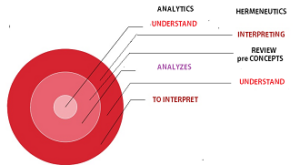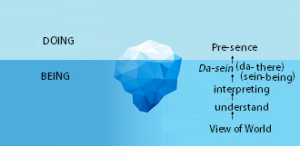
Posts Tagged ‘ontologia’
The whole, the part and the Being
It was from this theorization of the whole that Werner Heisenberg started the quantum principle, when he formulated his theory there was no answer from scientific experience, which in itself already contests empiricism, and it was a “theory” which in itself contests that reality is practical, but it was the first attempt, happy because later Physics and Science would come to their rescue, starting from the whole and not from the parts, as proposed by the Cartesian method.
started the quantum principle, when he formulated his theory there was no answer from scientific experience, which in itself already contests empiricism, and it was a “theory” which in itself contests that reality is practical, but it was the first attempt, happy because later Physics and Science would come to their rescue, starting from the whole and not from the parts, as proposed by the Cartesian method.
The truth of physics, however, changes over time, new discoveries about new discoveries of subparticles (among them the Higgs boson), the 7 states of matter (it joins the three widely known, the plasma (light liquid), Bose-Einstein states, fermionic gas and polarations superfluid, and there may be an eighth, so there is already a paraphysics.
But there is already, and there always was, metaphysics (later physics), modernity wanted to reduce it to subjectivity (something proper to the subject, but only stuck in his mind), the current ontology, the result of hermeneutics and phenomenology, it recovers by questioning the “veiling” of being, and proposes a clearing, the crisis of humanism is nothing other than this crisis.
The philosophical question about everything is “because there is everything and not nothing” and this supposes ex-sistence, as the question about the whole could be, it is not asked philosophically but only theologically, if there is “everything” which it is the intention that justifies the ex-sistence of everything ?.
Phenomenology recovers intentionality, a subcategory of consciousness in medieval philosophy, with a sense of being directed at something, or of being about something, thus ontological.
Husserl recovered it by directing it to an object, an essential category in modern idealism, but directing it to something that can be imaginary or real, thus including metaphysics and Being.
So the fantastic thing about the existence of everything is not just its existence, but the intention for the Whole.
What is the whole and if it exists is Being, so only He can Be beyond the whole universe that is locus, since in modern physics time is an abstraction, says Italian physicist Carlo Rovelli, who is among the most respected.
F or Christians, the entrance of God into the physis happens with Jesus, says the passage that Jesus asks who they say is “the son of man” (He thus speaks of one of his two natures: divine and human), and he goes to ask the apostles the who they say He is.
The apostles respond (Mt 16:14-16), they replied: “Some say it is John the Baptist; others that it is Elijah; still others, that it is Jeremiah or one of the prophets”. Then Jesus asked them, “And you, who do you say that I am?” Simon Peter replied, “You are the Messiah, the Son of the living God,” and Jesus says he is happy because it was God who revealed him.
Between Being, Nothing and interiority
The first ontological sensation, faced with rationality, was an attempt to confine Being in its subjectivity (which comes from the subject) in order to make the relationship with the Being an “objectivity” that exists outside of Being (for modernity outside the subject).
attempt to confine Being in its subjectivity (which comes from the subject) in order to make the relationship with the Being an “objectivity” that exists outside of Being (for modernity outside the subject).
As both deny ex-sistence, here it means ex “to leave” and the verb sistere, “to be placed”, so to exist is what is placed outside the being, more than subjectivity is the very essence of Being, beyond of the imaginary and the symbolic, of the imaginary because it is unrepresentable and the symbolic because it means the non-meaning, but there are all essence and existence of Being.
The conception of denying the existence of being, which has to deny even the reason that conceives it, comes from Gorgias (485-380 BC), a sophist whom Plato refuted in a book, for him there was no truth and it can be said that it is the distant principle for relativism.
The existence and reality of Being, although veiled, lies in the possibility of a clearing, on which depends the opening of Dasein, its relationship with the physis (nature in the general sense of the Greeks) and for which the veil that covers the being, and so the relationship with being and interiority.
If we see ourselves only as we see in a mirror, we see the image of our being, if we see as we are, it means that we are able to see beyond it our interiority, our complexity and from them how we relate to the whole of which we are part.
The projection on the exteriority and denial of interiority is part of the emptying of Being in modernity, we are what we do and it doesn’t really matter what we actually are interiorly.
From this emptying, nihilism (nihil – nothing) was born, solipsism (the I and my sensations) and, in a way, subjectivism (considerations only about what is personal, an empty interiority) and a good part of theorizations values in the infernal dichotomies (subject x object) and (nature x culture).
In a more current interpretation, in the Society of Tiredness Byung Chul Han speaks of interiority, in another book The Society of Transparency he states: “today the world is not a theater in which actions and feelings are represented and read, but a market where they are exposed , sells and consumes intimacies” (HAN, 2017, p. 80).
Han, Byung-Chul (2017). Transparency Society. Enio Paulo Giachini. Brazil: Petrópolis, Vozes, 2017.
The possible clearing
To scrutinize and investigate the unfathomable is man’s own, but there is always the possibility of daydreaming and well-constructed schemes of thought that do not lead to the clearing, just like an explorer in the forest, the risk of walking in circles without a compass, a river of guide or celestial stars are essential.
but there is always the possibility of daydreaming and well-constructed schemes of thought that do not lead to the clearing, just like an explorer in the forest, the risk of walking in circles without a compass, a river of guide or celestial stars are essential.
This has been happening since the beginning, warned Heraclitus in a fragment “The φύσις likes to hide herself”.
The φύσις (“Physis kryptesthai philei”) was left untranslated because literally it would be physis, but this was for the Greeks nature itself and what is now separated from it as Being, the dichotomy between subject and object.
In Heidegger, the truth is this abyssal foundation, hidden but possible to be unveiled, this is linked in this author by the link between being and truth as bottomless, abyssal foundation, the unfathomable, that’s why we explore in last week’s posts the metaphor , when contemplating being, this becomes ineffable.
What could be called ontological excess is nothing more than the mystery of being, its unfounded eschatology, it is neither a fragment of the universe, nor is it itself, part of it and incognito like it.
Truth is generally thought of as correction, agreement of a statement with what it says, or of a thing with what was previously thought of it, a hypothesis that seeks to make it true.
One can think of relativism, but it is exactly the opposite, for Heidegger the truth is always the truth, the experience of truth, from Plato to Husserl, was always an adaptation of representations, trying to escape from metaphors, with the essence of things themselves .
So truth is not being discoverer, but being discovered, Dasein (being there) is open to itself and to the world, and only in it can the originality of the phenomenon of truth be reached, what the Greeks called Aletheia , and that Heidegger goes further by proposing to be the institutor of the belonging of Being-Man.
This is the sense of the originality of Being, the being thinks in its primordial sense as “present”, Being is being in the present, it unveils itself in it,
Thus, the only sense that one could think of dialectics as ontology is the one in which the “basic feature of presenting itself is determined by remaining veiled and unveiled”, is Being in motion.
The reason we are trapped in the veiling of Being (its forgetfulness as Heidegger used to say) is the prison to logical-rational schemes to which the truth is tied to the entity and disconnected from Being.
HEIDEGGER, Martin. (1985) Alétheia. Os pensadores. Brazil, São Paulo : Abril Cultural, 1985.
From language to being
Language as speech and rhetoric is just what is externalized, but if thought of as ontology, it is the opening (Erschlossenheit) from the silent appropriation of the self, as Heidegger thought of Being and Time, whether the opening (offenheit) is thought of as clearing of being (lichtung des Seins), the one used by thinkers and poets, and which shows itself in the measure of its silent correspondence as being, expressed in Letter on Humanism.
thought of as ontology, it is the opening (Erschlossenheit) from the silent appropriation of the self, as Heidegger thought of Being and Time, whether the opening (offenheit) is thought of as clearing of being (lichtung des Seins), the one used by thinkers and poets, and which shows itself in the measure of its silent correspondence as being, expressed in Letter on Humanism.
In this text, he writes: “Destiny appropriates itself as a clearing of the Being, which it is, as a clearing. It is the clearing that grants the being’s proximity. In this proximity, in the clearing of Da Lugar, the man lives as a former caretaker, without him being able to experience and assume that dwelling today” (Heidegger, 1967, p. 61)
In general terms, language is a vehicle for the expression of something internal to man, that is, a bridge that links the inside and outside of man, such a way of speaking is thought of as an activity that takes place in which man is the very medium, that’s why there is silence before.
But according to the ontological conception of language, it is not language that belongs to man, but rather man himself conceived ontologically as a resolute being-toward-death or ontologically being that responds as mortal to the silent request of Being.
In more simplistic terms, this is the difference between the being that “has” a language, in the sense of the ability to speak, and the ontological conception that thinks man as “being” through being possessed of the ability to speak, the language here is not just the transmission of information, but the way in which human existence itself manifests.
In this context, communication begins with silence, an emptiness is needed, an epoché in communication, which presupposes an Other who will be a recipient, is not thus a receiver, but a destination of his speech, and this is the way in which human existence itself manifests. .
Thus for Heidegger, but also for Niklas Luhmann, it would be necessary to review the entire theory of Communication, since receiver and transmitter are themselves the non-human environment, and do not “replace” man, they cannot exist or have a relationship as if If man were something accessory, there is all the hallucination of the current Artificial Intelligence, putting receiver and transmitter in the place of source and destination, it would be necessary to foresee a “clearing” of the being “outside” of Being
For this reason, the clearing is internal, we have already posted in another opportunity what Heidegger affirms in his magnum work Being and Time: “Insofar as the being is in force from the aletheia, the self-unveiling emerging belongs to him. We call this the action of self-enlightenment and enlightenment, the clearing” (cf. Being and Time).
HEIDEGGER, Martin. Carta sobre o Humanismo (Letter on humanism). Brazil, Rio de Janeiro: Tempo Brasileiro, 1967, p. 61.
The hermeneutic circle and the metaphor
We are betrayed when we think we know and we are still in the initial stage of interpretation, the one that has not yet started a period process, to put our preconceptions in parentheses and start a real dialogue.
initial stage of interpretation, the one that has not yet started a period process, to put our preconceptions in parentheses and start a real dialogue.
Metaphor helps us to bring, using poetic language, a relationship of belonging, to bring the world to poetry and to bring poetry to the world, because the poem projects a world in its ontological dimension, a reality that lies between the seeing as of the metaphor itself to be.
In addition to this function in the scope of semantic innovation, the unveiling of deeper reality, for example, explaining issues that are complex in order to allow this belonging, this proximity, is the function, for example, of parables, metonymy and synecdoche.
Examples of more marked parables are the biblical ones, associating the Kingdom of God with seeds that grow unnoticed, or with the mustard seed, a tiny seed that becomes a tree, this to say that there is a life-giving force in man, and in all men.
However, metaphor, through the use of figurative language, always runs the risk of remaining on the surface.
We exemplified last week the biblical passage in which Jesus went to the seaside work of Galilee and a threat threatens the boat and Jesus calms the storm (Mark 4: 35-41), but the subtlety of this passage is the metaphorical meanings of going the other bank and the storm itself.
Needed to explain deeper things and questioned the disciples fear of storms, and goes to the other side, meaning a more direct moment with the apostles, much of the analytical exegesis (see previous post) is fixed on an immediate understanding that go to the other shore means changing the route, when in fact beyond resting (Jesus slept in the storm), as deeper realities were explained directly to the apostles.
This is proven if we verify that later Jesus returns “to the other bank” where he again encounters a crowd (Mk 5:21-43), and in this crowd he is beyond an unknown woman who touches the master’s robe and is cured of a hemorrhage of 12 years old, there is a synagogue chief named Jairus.
Jairus had the daughter in the last few years, and while he was with Jesus he asked him to lay hands on his daughter, friends of Jairus arrived, who said that she died and Jesus says that she “only sleeps”, goes to Jairus’ house and performs the miracle pronouncing the words “Talitá cum”, the girl gets up.
This subtlety, an ordinary person and a synagogue leader, shows very clearly that in the “crowd” there are also religious authorities who want signs (the Jews want signs and the Greeks wisdom) and so the metaphor is complemented with “signs” and a “wisdom” inherent in Jesus.
What is understanding
Understanding has become in the Western analytic structure a vicious circle that tends only to repeat what it considers to be true starting from some historical aphorism, what Gadamer calls romantic historicism in his criticism of Dilthey.
vicious circle that tends only to repeat what it considers to be true starting from some historical aphorism, what Gadamer calls romantic historicism in his criticism of Dilthey.
The forgetting of being ignores that the hermeneutic circle that goes from interpretation to a new understanding is the very structure of a new sense, a sense of existence, which is in Being.
Thus, the circularity of understanding is not primarily a logical requirement, based on an A or B method, but the ontological unfolding itself: “Heidegger’s hermeneutic reflection has its high point not in the fact that it demonstrates that a circle is present here, but a circle this has a positive ontological meaning” (GADAMER, 2013, p. 355).
Heidegger (2014), in his magna work Ser e Tempo, elaborated a hermeneutics of facticity based on the temporal analysis of human existence (Dasein), here facticity is the way of being in his Dasein that finds, in temporal existence, the possibility of revelation, of clearing:
“The structure of temporality appears as well as the ontological determination of subjectivity. But she was more than that. Heidegger’s thesis was that being itself is time” (Gadamer, 203, p. 345), here is the deepest essence of Heidegger’s work, which points to the hermeneutic circle:
“The decisive thing is not to leave the circle, but to enter it correctly. This circle of understanding is not an ordinary circle, in which any mode of knowledge moves, but it is the expression of the existential structure-of-previousness of Dasein itself. The circle must not be degraded into vitiosum nor be tolerated either. It shelters a positive possibility of the most original knowledge, a possibility that can only be truly realized in an authentic way, if the interpretation understands that its first, constant and last task consists in not letting the previous, the previous seeing and the preconception is given to it by occurrences and popular concepts” (Heidegger, 2014, p.433), but to address the same things.
Understanding seen in this way may seem too philosophical or a theorization about thinking, it is not, because, even in the oblivion of Being, the current frail structure of thought, this is the learning process that involves since the learning of language by a child even the most elaborate methods of discovery and innovation, or are just repetition of something already done, and thus without facticity, as it is mere repetition.
GADAMER, H-G. (2013) Truth and method Flávio Paulo Meurer, revision of the translation by Enio Paulo Giachini. 13. ed. Petropolis: Vozes; Bragança Paulista: São Francisco University Publisher, 2013.
HEIDEGGER, M. (2014) Ser e tempo Translation, organization, previous note, attachments and notes by Fausto Castilho. Campinas, SP: Publisher of Unicamp; Petrópolis, RJ: Editora Vozes, 2014.
The language as plurality
The problem of interpretation when we are thinking about language appears as a demonstrative proposition, it occurs when such an interpretation becomes unique and true, Heidegger’s proposal is one of the possibilities of language, but not the only or the main one, when we deal only with logic it does not understand the plurality of language.
appears as a demonstrative proposition, it occurs when such an interpretation becomes unique and true, Heidegger’s proposal is one of the possibilities of language, but not the only or the main one, when we deal only with logic it does not understand the plurality of language.
This is present in what today is called narrative or discourse, we have already dealt with in several posts when we deal with Paul Ricoeur’s Living Metaphor, but here the issue is ontological: Being.
Science and technique, as well as the ideological narrative does not even touch the essential problem of the question of being, it is focused on what is called natural science or nature:
“natural science can only observe man as something simply present in nature (…) within this scientific-natural project we can only see him as a natural being, that is, we intend to determine the being-man through a method which was absolutely not projected in relation to its peculiar essence” (Heidegger, 2001, p. 53).
This is the reverie of tradition in the conception of language and truth, the one that brings the notion of finitude of being: being is time, for example, accelerating time we think of accelerating being, when in fact it is what causes its emptying , a common theme of the Heideggerians.
We separate the ontological Being from the existential, quoting Heidegger himself, because the analytic falls into another trap which is to link the being to the subject, copula and attribute, creating a structural possibility of language. It is tempting precisely because of its analytic composition, but deep down it is essentially logical and not ontological, Being escapes it.
Such evasion was already foreseen by Heidegger: “the essence of being in its multiplicity can never, in general, be collected from the copula and its meanings” (HEIDEGGER, 2003, p.391).
Language carries its own hermeneutic relationship. Heidegger, based on Being and Time, relocates the question of understanding and the search for truth, which was placed in the scope of the theory of knowledge, and launches it into the existential plane. In this way, the hermeneutic circle emerges, not tied to mere opinion or to functional logicism, nor to the analytic.
Heidegger’s hermeneutic phenomenology brings to light the notion of logos as unveiling, highlighting their belonging to language as the place where the human inhabits, in its finiteness.
HEIDEGGER, M.(2001) Seminário de Zollikon Petrópolis: Vozes.
HEIDEGGER, M. (2003) Os conceitos fundamentais da Metafísica: mundo, finitude, solidão. Rio de Janeiro: Forense Universitária.
The knowledge and doing
The society we live in is a performance society, as  Byung Chul Han calls it, who did his doctorate at Heidegger, it is a society of doing, but not of knowing how to do.
Byung Chul Han calls it, who did his doctorate at Heidegger, it is a society of doing, but not of knowing how to do.
Remembering “old theorists”, deifying ancient theories that had a determined temporal functioning, constitutes the setback and crisis of philosophy, not of thought, because man as a Being is capable of unveiling and discovering, because there is a forgetfulness of being.
Knowledge not closed in logic, with openness and possibility of new discoveries is the constitutive movement of time, there is not something fully understood and finished, it is constitutive of what happens in time, and it is subject to history, it is knowledge practical and of life, a Lebenswelt as Husserl called him.
Heidegger started from there with the direct influence of Husserl, the meaning of his Phenomenology supposes this opening for seeing things as they manifest themselves, the principle of knowledge.
Thus, there is not something understood, finished, what there is is a comprehensibility in a constant becoming, implying practical knowledge, a know-how that is more than the objective of science, it must be the foundation of every comprehensive act as one that seeks to know.
The essential opening is not for the hermeneutic consciousness as seen by Heidegger a primarily rational act, it is an affective disposition, one of the structural existences of the being-there, it is shown that understanding is always an affective understanding, in the sense of “affecting”.
Interpretation follows affection, but what is interpreting here if not revisions and elaborations of meaning, set in motion, thus interpretation is for Heidegger:
“The interpretation of something as something is essentially based on having-prior, seeing-prior and concept-prior. Interpretation is never an unassuming apprehension of something previously given […]” (HEIDEGGER, 2014, p. 427).
One of Heidegger’s central philosophical problems is the question about the possibilities of language, it is from this that the Being elaborates its worldview, from which it cannot escape, it enables us to understand the world, it elaborates the being-in -world.
Being in the world that would imply know-how depends on the worldview, impoverished and obscured by performance, the demand for efficiency and poor articulation with time.
HEIDEGGER, M. Ser e tempo (Being and time) Translation, organization, previous note, attachments and notes by Fausto Castilho. Campinas, SP: Publisher of Unicamp; Petrópolis, RJ: Editora Vozes, 2014.

